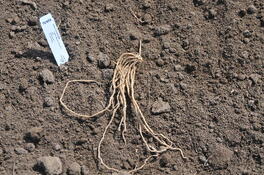 We sometimes receive questions as to whether asparagus or rhubarb can be moved in the fall. Though these crops are traditionally transplanted in the spring (mid-March to mid-April), a fall move can be successful. Wait until the top has been browned by frost and then cut back to the ground. Prepare the soil and fertilize as you would in the spring. See http://www.bookstore.ksre.ksu.edu/pubs/mf319.pdf for more detail on asparagus and http://www.bookstore.ksre.ksu.edu/pubs/ep99.pdf for more information on rhubarb. Water well after planting to ensure good root/soil contact. Mulching would be helpful on the rhubarb to prevent the plant from heaving out of the soil during the winter but asparagus requires no such treatment as it is planted much deeper. (Ward Upham) 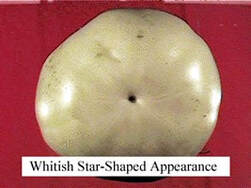 Cooler nights are increasing in frequency now that we are into October. If you have tomatoes, you may have some that are approaching maturity. Leave them on the vine until mature or until a frost is forecast. Tomatoes will ripen off the vine but must have reached a certain phase of maturity called the ‘mature green stage.’ Look for full-sized tomatoes with a white, star-shaped zone on the bottom end of the green fruit. When harvesting fruit before a frost, separate tomatoes into three groups for storage: those that are mostly red, those that are just starting to turn, and those that are still green. Discard tomatoes with defects such as rots or breaks in the skin. Place the tomatoes on cardboard trays or cartons but use layers of newspaper to separate fruit if stacked. Occasionally a tomato may start to rot and leak juice. The newspaper will keep the juice from contacting nearby or underlying fruit. Store groups of tomatoes at as close to 55 degrees as possible until needed. (Ward Upham) 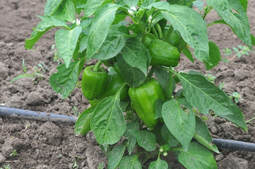 Peppers are able to be stored fresh much longer than tomatoes. They can usually keep in a crisper drawer of a refrigerator for several weeks if kept moist but not wet. For longer storage, freezing works well. Though mushy when thawed, the flavor still comes through in cooked foods. Try dicing them into small pieces and then freezing on a cookie sheet. The frozen pieces can then be poured into a plastic bag for later use. Measuring is much easier as the pieces are not frozen together in a clump. This methods works equally well for hot peppers but be sure to wear gloves when handling. (Ward Upham) 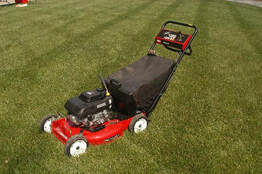 Sometimes you will hear people say to let the grass grow tall right before winter sets in. Their reasoning is that the extra foliage will insulate the crown of the plant from the extreme cold of winter. Although this may sound reasonable, in practice it probably does little, if anything, to increase winter hardiness. On the contrary, a canopy that is too high during the winter may lay over and become matted down, leading to an increased incidence of winter-diseases such as snow mold. Turfgrass species vary genetically in their cold tolerance, with warm-season grasses such as bermudagrass, zoysiagrass and buffalograss being less cold tolerant than the cool-season types such as tall fescue and Kentucky bluegrass. Given these differences, cold tolerance is improved by increasing the health of the plants going into the winter, and healthy plants are a result of a sound management program (fertilizing, watering and mowing) during the spring, summer and fall. The lawn will benefit more from continuing to mow at the recommended height than from trying to gain some insulation against winter cold by allowing it to grow tall. Here is a list of the recommended mowing height ranges (in inches) for home lawns in Kansas: Tall fescue 2.5 -3.5 Kentucky bluegrass 2-3 Buffalograss 2-3 Bermudagrass 1-2 Zoysiagrass 1-2 (Note: Mowing at heights below 1.5 inches requires a reel mower). There may be some benefits gained by adjusting mowing heights WITHIN the recommended range at times. For example, it is a good practice to mow warm-season grasses at the higher end of recommended heights during late summer and early fall because this practice should help them store more carbohydrate reserves for the winter, and it may reduce the incidence of certain cool-weather diseases. But the rule to remember is to stay within the recommended height range for your species. (Ward Upham) 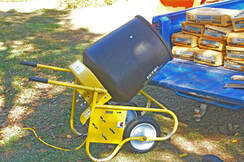 Sand is sometimes suggested as an amendment material for clay soils. However, there is good reason to be cautious about using sand. In order for sand to be effective in breaking up a clay soil, sand grains must touch one another so there are pore spaces between grains that can hold air and/or water. If the grains do not touch, the clay fills in all the voids between the sand particles leaving no room for pores. This is the same principle used to make concrete and the result is somewhat the same. You end up making a bad situation worse. So how much sand does it take for it to be effective? Normally, we consider about 80 percent sand to be sufficient. In most cases this makes the use of sand impractical. The addition of organic matter is a much better choice. (Ward Upham) 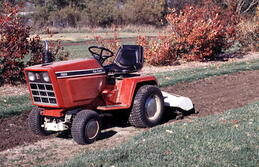 Fall is the preferred time to prepare garden soil for next spring’s vegetable garden. Spring is often wet making it difficult to work soil without forming clods that remain the rest of the season. Fall usually is drier allowing more time to work the soil when it is at the correct soil moisture content. Even if you work soil wet in the fall and form clods, the freezing and thawing that takes place in the winter will break them down, leaving a mellow soil the following spring. Insects often hide in garden debris. If that debris is worked into the soil, insects will be less likely to survive the winter. Diseases are also less likely to overwinter if old plants are worked under. Also, the garden debris will increase the organic matter content of the soil. Working the debris into the soil is often easier if you mow the old vegetable plants several times to reduce the size of the debris. Fall is an excellent time to add organic matter. Not only are organic materials usually more available in the fall (leaves, rotten hay or silage, grass clippings) but fresher materials can be added in the fall than in the spring because there is more time for materials to break down before planting. As a general rule, add 2 inches of organic material to the surface of the soil and till it in. Be careful not to overtill. You should end up with particles like grape nuts or larger. If you work your garden into the consistency of dust, you have destroyed the soil structure. (Ward Upham) 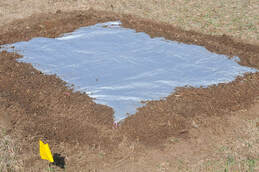 If you plan to develop or add to your fruit garden next year, now is a good time to begin preparing the planting site. Grass areas should be tilled so grass does not compete with the fruit plants for soil moisture and nutrients. Have the soil analyzed for plant nutrients. Your local K-State Research and Extension agents have information to guide you in taking the soil sample. From that sample, the agent can provide recommendations on what and how much fertilizer to add to correct nutrient deficiencies. Organic materials such as compost, grass clippings, leaves, hay, straw or dried manure, can be tilled into the soil to help improve its condition. Do not use grass clippings that have been treated with a crabgrass killer as tree growth may be affected. Lawns treated with crabgrass preventers are fine to use but avoid those treated with crabgrass killers. Time and weather conditions generally are more suitable in the fall than in the late winter and spring for preparing soil. If fruit plants can be set by early April, they will have developed a stronger root system to support plant growth than they would if planted later. If there are only a few plants to be planted, consider tarping each planting area to guard against a wet spring delaying planting after plants are shipped and received. Also, fruit tree planting can be done in the fall but plants may need to be watered during the winter if the weather is warm and dry. (Ward Upham) 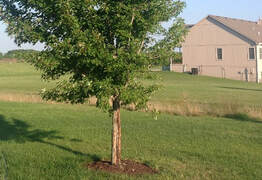 Many young, smooth, thin-barked trees such as honeylocusts, fruit trees, ashes, oaks, maples, lindens, and willows are susceptible to sunscald and bark cracks. Sunscald normally develops on the south or southwest side of the tree during late winter. Sunny, warm winter days may heat the bark to relatively high temperatures. Research done in Georgia has shown that the southwest side of the trunk of a peach tree can be 40 degrees warmer than shaded bark. This warming action can cause a loss of cold hardiness of the bark tissue resulting in cells becoming active. These cells then become susceptible to lethal freezing when the temperature drops at night. The damaged bark tissue becomes sunken and discolored in late spring. Damaged bark will eventually crack and slough off. Trees often recover but need special care — especially watering during dry weather. If you have seen this type of damage in previous years or fear you have susceptible trees, preventative measures are called for. Applying a light-colored tree wrap from the ground to the start of the first branches can protect young and/or recently planted trees. This should be done in October to November and removed the following March. Failure to remove the tree wrap in the spring can prove detrimental to the tree. (Ward Upham) |
AuthorsCynthia Domenghini runs the Horticulture Response Center in the Department of Horticulture and Natural Resources at Kansas State University. Other contributors include K-State Extension Specialists. Archives
March 2024
Categories
All
|
| K-State Research and Extension Horticulture Newsletter |
|
 RSS Feed
RSS Feed
